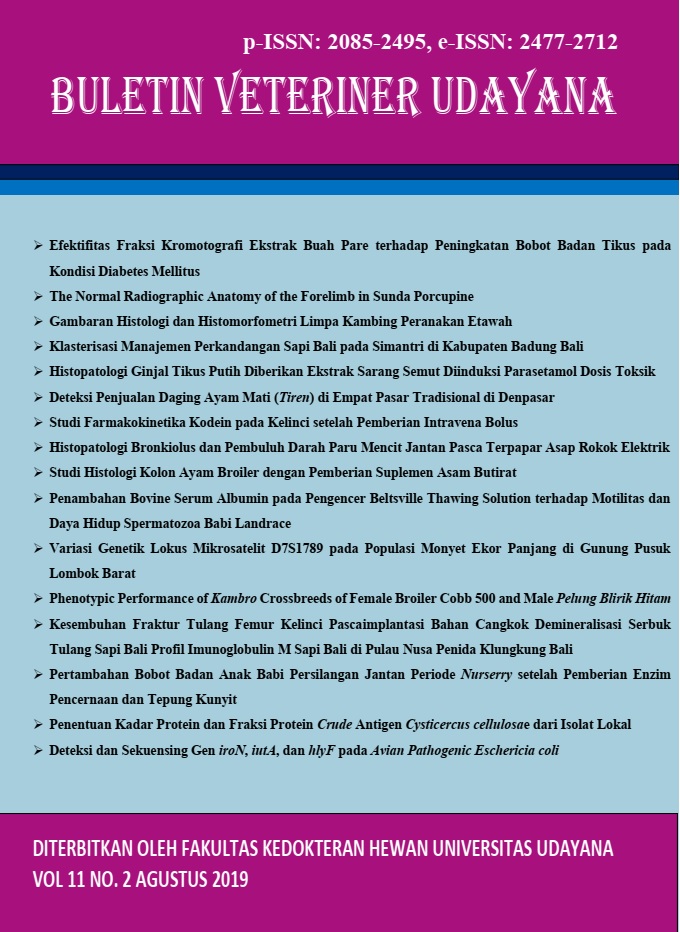A HISTOLOGICAL STUDY OF BROILER CHICKENS COLON GIVEN BUTYRIC ACID SUPPLEMENTS
Abstract
This study aims to determine the differences dosage and duration of butyric acid supplements on the layer thickness of colon broiler chicken. The sample consisted of 24 broiler chickens. This study used a Completely Randomized Design 3x4 factorial pattern that consisted of 3 factors of supplement dosage (0; 0.5; and 1 g supplement/ kg of feed) and duration of administration (1,2,3 and 4 weeks). Samples were divided into 3 groups: control group (P1), the group with butyric acid supplementation 0.5 (P2), and group with 1 g supplement/kg of feed (P3). Every week, two broiler chickens from each group were necropsied and the colonic tissue was taken for histologically preparations using HE staining. The changes observed were on the thickness of mucosal, submucosal, muscular, and serous’s layer and then examined under a microscope and then calculated using ZEN applications. Data were analyzed using Analysis of Variance and followed by Duncan test if there is a significant difference. The results showed the difference in the dose of butyric acid did not affect the thickness of the colon layer but it affects the colon histological changes. The difference in the duration of butyric acid administration affects the thickness of the tunica mucosa, submucosa, muscular, and serosa. It is concluded that the administration of butyric acid between doses 0; 0,5; and 1 g/kg chicken food did not affect for the thickness of the mucosal, submucosal, muscular, and serous’s layer, but it affected the presence of the colon histological changes. Differences in the duration of butyric acid’s administration at week 1,2,3,4 affects the thickness of the mucosal, submucosal, muscular, and serosal’s layer of broiler chicken.
Downloads
References
Bacha WJ, Bacha LM. 2012. Color atlas of veterinary histology. 3rd Ed. UK, John Wiley & Sons, Ltd.
Banks J. 1981. Applied veterinary histology. London, Williams and Wilkins Baltmore. Pp: 102.
Baum B, Meneses F, Kleinschmidt S, Nolte I, Trautwein MH. 2007. Age-related histomorphologic changes in the canine gastrointestinal tract: A histologic and imunohistologic study. World J. Gastroenterol. 13(1): 152-157.
Canani RB, Costanzo MD, Leone L, Pedata M, Meli R, Calignano A. 2011. Potential beneficial effects of butyrate in intestinal and extraintestinal diseases. World J. Gastroenterol. 17(12): 1519-1528.
Cassidy MM, Fitzpatrick LR, Vahouny GV. 1984. The effect of fiber in the postweaning diet on nutritional and intestinal morphological indices in the rats. 2nd Washington Symp. Dietary Fiber.
Comalada M, Bailon E, Villoslada ODHFL, Xaus J, Zarzuelo A, Galvez J. 2006. The effects of short-chain fatty acids on colon epithelial proliferation and survival depend on the cellular phenotype. J. Cancer Res. Clin. Oncol. 132: 487-497.
Dehkordi RF, Ghahremani P. 2015. Developmental study of rectum in broiler chicken: A stereological and morphometrical study. Vet. Res. Forum. 7(1): 41-45.
Fernandes BCS, Martins MRFB, Mendes AA, Milbradt EL, Sanfelice C, Martins BB, Aguiar EF, Bresne C. 2014. Intestinal integrity and performance of broiler chickens fed a probiotic, a prebiotic, pr an organic acid. Braz. J. Poult. Sci. 16(4): 417-424.
Fernandes T, Oliveira MI, Castro R, Araujo B, Viamonte B, Cunha R. 2014. Bowell wall thickening at CT: simplifying the diagnosis. Insights Imaging. 5: 195-208.
Ganong WF. 1995. Fisiolofi kedokteran. Edisi 14. Jakarta, Penerbit Buku Kedokteran EGC.
Hamedi S, Shomali T, Akbarzadeh A. 2013. Prepubertal and pubertal caecal wall histology in Japanese quails (Coturnix coturnix japonica). Bulgarian J. Vet. Med. 16(2): 96- 101.
Hamer HM, Jonkers D, Venema K, Sanvhoutvin S, Troost FJ, Brummer RJ. 2008. Review Article: the role of butyrate on colonic function. Aliment. Pharmacol. Ther. 27: 104–119.
Karaki S, Kuwahara A. 2010. Roles of Short-Chain Fatty Acids and their Receptor in Colonic Motility. Biosci. Microflora. 29(1): 31-40.
Khan SH, Iqbal J. 2016. Recent advances in the role of organic acids in poultry nutrition. J. Appl. Anim. Res. 44(1): 359-369.
Liu W, Yang Y, Zhang J, Gatlin DM, Ringo E, Zhou Z. 2014. Effect of dietary microencapsulated sodium butyrate on growth, intestinal mucosal morphology, immune response and adhesive bacteria in juvenile common carp (Cyprinus carpio) pre-fed with or without oxidised oil. British J. Nutr. (112): 15–29.
Murdiati TB. 1997. Pemakaian antibiotika dalam usaha peternakan. Wartazoa. 6(1): 18-20.
Ochiai K, Ochiai TK. 2006. Effect of butyric acid on the periodontal tissue. Jap. Dental Sci. Rev. 45: 75-82.
Putra IGNY, Sudarma M, Djelantik AAAW. 2015. Faktor-faktor yang mempengaruhi masyarakat membeli daging ayam boiler di Kabupaten Bangli. E-J. Agrib. Agrowisata. 4 (1): 47-55.
Teirlynck E, Bjerrum L, Eeckhaut V, Huygebaert G, Pasmans F, Haesebrouck F, Dewulf J, Ducatelle R, Van Immersel F. 2009. The cereal type in feed influences gut wall morphology and intestinal immune cell infiltration in broiler chickens. British J. Nutr. 102: 1453-1461.
Uni Z, Noy Y, Sklan D. 1996. Developmental parameters of th small intestines in heavy and light strain chicks pre and post-hatch. British Poult. Sci. 36: 63-71.
Van Immerseel F, Boy ENF, Gantois I, Timbermont L, Bohez L, Pasmans F, Haesebrouck F, Ducatelle R. 2005. Supplementation of coated butyric acid in the feed reduces colonization and shedding of Salmonella in poultry. Poult. Sci. 84: 1851-1856.
Woong KJ, Hyuk KJ, Yong KD. 2015. Dietary organic acids for broiler chickens: a review. Rev. Colomb. Cienc. Pecuar. 28(2): 109-123.
Zaleski A, Banaszkiewicz A, Walkowiak J. 2013. Butyric acid in irritable bowel syndrome. Prz. Gastroenterol. 8(6): 350–353.
Zavarize KC, Sartori JR, Gonzales E, Pezzato AC. 2012. Morphological changes of the intestinal mucosa of broilers and layers as affected by fasting before sample collection. Braz. J. Poult. Sci. 14(1): 21-25.





